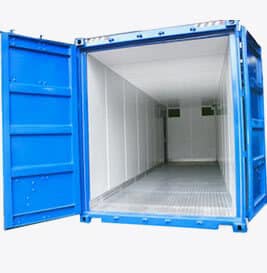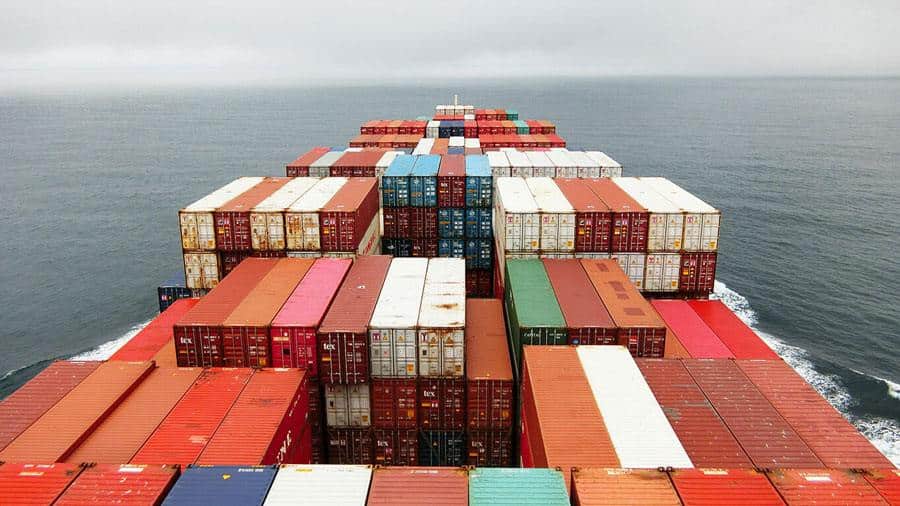The below estimate is assuming you have standard furniture items and boxes for a single-family residence. For customized volume calculation, you can use our CFT calculator to determine the volume accurately.
The below chart will assist you to determine the cubic feet volume you should expect depending on the number of bedrooms or square feet of your residence.
The below estimate is assuming you have standard furniture items and boxes for a single-family residence. For customized volume calculation, you can use our CFT calculator to determine the volume accurately.
Depending on volume you plan to move, below are different ocean container specifications. If your volume is under 500 CFT you should consider shipping by LCL (Less than Container Load)

Types of Ocean Containers
There are different types of ocean containers, each designed for a specific purpose. The most common types include dry containers, refrigerated containers, open-top containers, flat rack containers, and tank containers.
- Dry Containers: These are standard containers that are used to transport dry goods such as electronics, clothing, furniture, and other non-perishable items.
- Refrigerated Containers: Also known as reefers, these containers are used to transport perishable goods such as fruits, vegetables, meats, and pharmaceuticals. They have a temperature-controlled environment that ensures the goods remain fresh during transit.
- Open-Top Containers: These are containers that have no roof and are used to transport oversized goods such as machinery, construction equipment, and vehicles.
- Flat Rack Containers: These containers are designed for transporting large, heavy, and bulky items such as machinery, pipes, and steel rods.
- Tank Containers: These containers are used to transport liquids such as chemicals, fuels, and food-grade liquids.
Sizes and Capacity of Ocean Containers
Ocean containers come in different sizes, with the most common being 20ft and 40ft containers. The 20ft container has a capacity of 1,170 cubic feet and can hold up to 10 standard pallets, while the 40ft container has a capacity of 2,390 cubic feet and can hold up to 20 standard pallets. There are also high cube containers that are one foot taller than standard containers, providing extra capacity.
Shipping Procedures for Ocean Containers
When shipping goods in ocean containers, it’s essential to understand the shipping procedures. These procedures include booking, loading, and customs clearance.
- Booking: Before shipping your goods, you need to book a container with a shipping line or freight forwarder. You should provide information about the type of goods you are shipping, the size and weight of the cargo, and the destination port.
- Loading: After booking the container, you need to load the goods into the container. It’s essential to ensure that the cargo is properly packed, labeled, and secured to avoid damage during transit.
- Customs Clearance: When the container arrives at the destination port, it needs to go through customs clearance. You need to provide the necessary documentation, including the bill of lading, packing list, and commercial invoice.
Benefits of Using SFL Worldwide for Booking Ocean Containers
Booking ocean containers can be a daunting task, especially if you are not familiar with the shipping procedures. That’s where SFL Worldwide comes in. SFL Worldwide is a leading logistics provider that specializes in ocean freight, air freight, and ground transportation. Here are some of the benefits of using SFL Worldwide for booking ocean containers:
- Expertise: SFL Worldwide has a team of experts who are knowledgeable about the shipping procedures and can guide you through the entire process.
- Competitive Rates: SFL Worldwide offers competitive rates for ocean containers, helping you save money on shipping costs.
- Tracking: SFL Worldwide provides real-time tracking for your ocean containers, allowing you to monitor your cargo’s location during transit.
- Customs Clearance: SFL Worldwide can help you with customs clearance, ensuring that your cargo is cleared quickly and efficiently.
In conclusion, ocean containers are an essential part of the global trade industry, and understanding their types, sizes, capacity, and shipping procedures is crucial if you want to transport your goods overseas. SFL Worldwide offers expertise, competitive rates, tracking, and customs clearance services, making it the ideal logistics provider for booking ocean containers.
Whether you are shipping perishable goods, oversized items, or liquid cargo, SFL Worldwide can help you transport your goods safely and efficiently. Contact SFL Worldwide today to learn more about their ocean container services and how they can help you with your shipping needs.
Final Thoughts
In conclusion, understanding everything about ocean containers is essential if you want to transport your goods overseas. From the types and sizes of containers to the shipping procedures and logistics providers, every detail matters when it comes to ocean container shipping.
Using the right logistics provider like SFL Worldwide can make all the difference in your shipping experience. With their expertise, competitive rates, tracking, and customs clearance services, you can be sure that your cargo will arrive safely and on time. So, don’t hesitate to contact SFL Worldwide today to book your ocean container and start shipping your goods across the sea.

I’m Tammy Waller, a supply chain and logistics specialist with over 10 years of expertise. I’ve been an author and SFL employee for over 10 years.
As an author, I’ve been able to teach others. I love guiding users through supply chain and logistics operations.
I have substantial experience managing logistics operations, supply chain management, transportation, inventory management, and warehousing in shipping-moving and logistic services. I’ve worked on many worldwide logistics and supply chain projects, honing my abilities in negotiating rates, scheduling shipments, and managing vendors.



